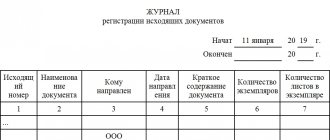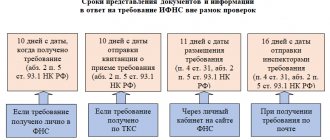Rules and terms for storing documents
The rules for storing documents are enshrined at the state level in the Rules for organizing the storage, acquisition, recording and use of documents of the Archive Fund of the Russian Federation and other archival documents in government bodies, local governments and organizations, approved by order of the Ministry of Culture of the Russian Federation dated March 31, 2015 No. 526.
Based on storage periods, documents can be divided into 3 groups:
- permanent storage,
- temporary storage over 10 years,
- temporary storage up to 10 years.
Refer to standard lists for storage periods for documents. The main one used in any organization is the List of standard management documents generated in the activities of state organizations, local governments and organizations, indicating their storage periods, approved by Order of the Ministry of Culture of Russia dated August 25, 2010 No. 558.
In order to organize the storage of a large volume of documents, organizations create an archive - an independent structural unit that ensures the safety of documents with long storage periods. At the same time, cases that have a storage period of more than 10 years are transferred to the archive no earlier than one year and no later than 3 years after their completion. Documents with a temporary storage period of up to 10 years are not transferred to the archive and are stored in the structural units in which they were created.
If an organization does not have the opportunity to store documents at its location, then it can enter into a depository storage agreement with specialized organizations that will independently monitor the safety of documents and destroy them in a timely manner.
Formed and completed files, before they are transferred to the organization’s archive, are stored in structural units that must ensure the safety of documents and protection from the negative effects of light and dust.
Grouping documents into cases
* organization of personnel work * structure, composition * tasks of the personnel service * job descriptions of employees of the personnel department * regulatory documents for the formation of document flow of the personnel department * list of necessary personnel documents, types and varieties of personnel documentation * nomenclature of files grouping documents into files * requirements for the preparation of personnel documentation , giving documents legal force * instructions for personnel records management * preparation of personnel service files for transfer to the organization's archive, storage periods * employer's responsibility for violation of requirements for maintaining personnel records
Formation of personnel documents into files and organization of their current storage
All documents generated in the activities of the organization are formed into files.
And HR documents are no exception. How to organize the storage of personnel documents? Personnel documents created by the personnel service are of particular importance, because they contain personal data of employees and confirm their work experience with all its features. Given the great value of the information contained in such documents, they should be stored in conditions that would ensure their protection from harmful environmental influences, damage and loss. Personnel documents must be compiled into files and stored properly. Moreover: in the first part of Article 17 of the Federal Law of October 22, 2004 No. 125-FZ “On Archival Affairs in the Russian Federation”, documents on personnel are especially highlighted among those archival documents whose safety is required to be ensured by state bodies, local governments, and organizations and citizens engaged in entrepreneurial activities without forming a legal entity. The safety of documents is ensured during the stipulated storage periods. Explanatory dictionary
Documents on personnel - archival documents reflecting the labor relationship of the employee with the employer (Clause 3, Part 1, Article 3 of the Law on Archival Affairs). A file
is a collection of documents (or a document) related to one issue or area of activity, placed in a separate cover (GOST R 51141 - 98 “Office work and archiving. Terms and definitions”).
Formation of a case
- grouping executed documents into a case in accordance with the nomenclature of cases and systematization of documents within the case (GOST R 51141 -98).
Basic rules for forming cases.
With the onset of the new calendar year, each organization begins to formulate its documents into files in accordance with the approved nomenclature of files. As a rule, this happens in a decentralized manner, that is, not throughout the organization as a whole, but in individual structural units. Thus, the personnel service independently generates personnel documents for files. In this case, the service may have an employee responsible for the formation of cases. Why is it necessary to form documents into cases? First of all, this procedure ensures a quick search for documents and their use in the future. Agree: it is much easier to find a document that is filed in chronological order in a folder with a certain heading than if the same document was stored for years in a large file with all the other papers created on a variety of issues. In addition, proper registration of files for current storage facilitates future work on preparing documents for transfer to the archive. Documents on personnel, as a rule, have a long shelf life of 75 years, which means that at some point there will be a need to prepare them for archival storage. And the better the work done on the registration of current files, the less time will be spent in the future on preparing them for long-term storage. In order to avoid having to reorganize and re-register files when transferring them to the archive, form them according to established rules already in office work. When forming personnel service files and organizing their storage, it is necessary to be guided by the Basic Rules for the Operation of Organizational Archives (approved by the decision of the Board of Rosarkhiv on 02/06/2002). However, this document is not a normative act that is mandatory for use. In addition, the Basic Rules do not fully reflect the specifics of the formation of personnel documents in cases. Therefore, when considering the technology of working specifically with personnel documents, we largely have to rely on those techniques that have developed in the practice of working with documents, including in archives storing documents on personnel. Documents generated in the activities of the personnel service are stored in files, in the form of magazines (books), in the form of card files. There are several rules for forming cases. Rule 1. Documents are formed into files strictly in accordance with the nomenclature of the organization’s files. Let us remind you: when compiling a nomenclature of cases and including case titles in it, you can be guided by different criteria. For example:
| Sign for forming cases | The principle of document formation | Example of a case title |
| Nominal | By the name of the type of document | Orders on main activities |
| Subject-question | According to the content of documents | Documents on personnel selection and hiring (certificates, announcements, lists) |
| Author's | According to the author of the document. Involves grouping documents of one author into a file | Minutes of meetings of the certification commission |
| Correspondent | Used to group correspondence. The title of the case indicates the correspondent with whom the correspondence is being conducted and the content of the question is revealed. | Correspondence with educational institutions about student internships |
| Geographical | Serves to unite several correspondents in one case | Correspondence with organizations in Eastern Siberia regarding the organization of work on a rotational basis |
| Chronological | Used to group documents for a specific period | Quarterly reports on the work of the HR department in 2010. |
Regardless of how the list of cases is fixed in the nomenclature, cases must be formed strictly in accordance with the nomenclature.
It is prohibited to include documents in files in any other way. Rule 2. The case is considered opened from the moment at least one document is filed in it. Rule 3. Simultaneously with the inclusion of documents in the file, its cover is drawn up. The design of the cover of the case consists of putting certain information on it: - name of the organization; — name of the structural unit; — index (number) of the case; - title of the case; — storage period for case documents. The name of the organization and the name of the structural unit are indicated in exact accordance with the officially established name. The case index is transferred to the cover from the list of cases. The title is written on the cover of the case in strict accordance with the nomenclature of cases of the personnel service. The storage period for documents is also indicated in accordance with the nomenclature of cases. Question. At the beginning of autumn, the organization changed its name. There are many cases in the current paperwork, including cases with documents on personnel. At the same time, the previous name of the organization is indicated on all covers. Is it necessary to re-register all files (change the covers of files) available in the organization’s records management?
Answer: In the situation under consideration, there is no need to reissue the covers of the cases. If the name of an organization changes during the period covered by the case documents, the new name of this organization is indicated on the cover of the case, and the previous name is enclosed in brackets. Rule 4. Only executed, correctly executed documents containing all the necessary details are placed in the files. Rule 5. One copy of each document is included in the file. Rule 6. The files include original documents, with the exception of certain cases. The case may contain a copy of the document when the original is sent to another organization (or citizen), and the author retains a second copy (copy). This mainly concerns correspondence. If the organization maintains personal files of employees, then copies of the following documents are placed in them: - orders for personnel (on hiring, transfers, dismissal, promotion, etc.); — documents on education, advanced training, assignment of a rank or a second profession, etc. Most personnel documents are stored in the originals: orders for personnel and other administrative documents, local regulations (rules, regulations, instructions, etc.), personal cards of employees , accounting and registration books, magazines, memos, employment contracts, etc. Rule 7. Draft documents, duplicate copies, as well as documents subject to return are not placed in the files. Rule 8. Some types of documents must be grouped into cases separately. The following are grouped separately: • documents of permanent and temporary storage; • different types of administrative documents; • originals and copies of documents; • annual, quarterly and monthly plans and reports; • approved documents and their projects. Rule 9. Documents from one calendar year are placed in the case. The exceptions to this rule are: moving files, personal files that are formed during the entire period of work of a particular employee, documents of commissions that are grouped into a file during the period of their activity, and some other documents. Rule 10. No more than 250 sheets can be placed in a case (the thickness of the case is no more than 4 cm). With a larger number of documents, volumes (parts) of cases are formed. Rule 11. Inside the case, documents are arranged in a certain order. Documents in cases are grouped according to chronological or thematic criteria or a combination of both.
Grouping documents into cases.
| Documentation | Rules for grouping documents into cases |
| Incoming documents | Grouped into cases by date of receipt |
| Outgoing documents | Grouped into cases by dispatch date or alphabetically by authors and correspondents |
| Local regulations approved as independent documents | Grouped into cases by type and chronology with related applications within one calendar year |
| Local regulations approved by administrative documents | They are appendices to administrative documents (orders, instructions, decisions, resolutions) and are grouped into cases together with the specified documents |
| Orders on main activities | They are grouped separately from orders by personnel. Genuine copies are systematized and filed in files along with attachments in the order of their numbers |
| Documents for orders on core activities | They are grouped and filed separately from orders for the main activity and are stored with the person who prepared their projects |
| Orders for personnel | Grouped into cases in accordance with the established retention periods |
| Correspondence | Grouped by calendar year and systematized in chronological order: the response document is placed in the file behind the request document. When correspondence on a particular issue that began in the previous year is resumed, the documents are included in the current year's file, indicating the index of the previous year's file. Depending on the specifics of the organization’s activities, correspondence can also be grouped by academic year, term of convening of elected bodies, etc. |
| Protocols | Arranged in chronological order according to the date of their compilation |
| Instructions from higher organizations and documents for their execution | Grouped into cases according to the areas of activity of the organization |
| Approved plans, reports, estimates, title lists | Grouped separately from their projects |
| Planning and reporting documents | Stored in the files of the year to which they relate in their content, regardless of the time of their compilation or date of receipt |
| Long-term plans for several years | They are compiled in the first year’s file, and reports on the implementation of these plans are in the last year’s file. |
| Documents in personal files | Arranged in chronological order as they are received. |
| Personal cards of employees | Formed into cases alphabetically by last name |
| Personal accounts for employee wages | Grouped into independent cases and arranged in them in alphabetical order of surnames |
Rule 12. Annexes to documents, regardless of the date of their approval or preparation, are attached to the documents to which they relate; applications over 250 sheets are allocated into a separate volume (part).
Procedure for forming cases
Formation of cases
is the grouping of executed documents into cases in accordance with the nomenclature of cases and their systematization within the case.
If the organization is small, then this work is performed by the secretary. If the organization has structural divisions, then the affairs of their employees are formed independently.
There are rules for forming cases that should be followed:
- place in the case only executed, correctly executed documents in accordance with the headings of the cases;
- place together all documents related to the resolution of one issue;
- place attachments together with the main documents;
- group documents of the same calendar year into one file, with the exception of transferable cases;
- group documents of different retention periods into separate files.
These features can be supplemented and combined with each other.
Only one copy of each document is included in the file. Draft copies and copies are destroyed.
One case should have a volume of no more than 250 sheets with a thickness of no more than 4 cm. Such sizes of cases make it easy to pick up, carry cases and use them later.










